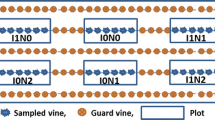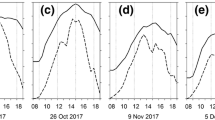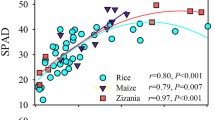Abstract
In-season N applications to processing potato crops may increase profits and improve N fertilizer use efficiency. The objective of our study was to evaluate indices to predict the differential economic optimum N rate (dEONR) using a SPAD 502 chlorophyll meter, a Crop Circle ACS-210 (CC), and a Green Seeker 506 (GS). Additionally, algorithms were developed to determine N fertilizer variable rates. The relative chlorophyll meter reading (RCM), the relative chlorophyll index (RCI), and the relative normalized differential vegetative index (RNDVI) were calculated using the mean sensor value divided by the value determined in plots with the highest N rate within each site-year. The relationship between relative indices and dEONR was evaluated by fitting quadratic and quadratic-plateau regression models. The canopy chlorophyll indices (RCM and RCI) were significantly associated with dEONR during the growing season (R2 = 0.48, 0.22 at 40 days after planting (DAP), R2 = 0.28, 0.73 at 60 DAP, R2 = 0.62, 0.82 at 80 DAP, R2 = 0.58, 0.83 at 100 DAP for RCM and RCI, respectively). The canopy biomass index (RNDVI) was significantly associated with dEONR only at tuber bulking (R2 = 0.51, 0.85 at 80 DAP and R2 = 0.48, 0.51 at 100 DAP, for GS and CC, respectively). The canopy chlorophyll indices performed better than the canopy biomass indices in measuring N stress. The optical sensor CC was better than the GS in predicting N stress because it measures the RNDVI and the RCI in a single reading.
Resumen
La aplicación de N durante el ciclo del cultivo de papa para industria puede aumentar los beneficios y mejorar la precisión de la fertilización nitrogenada. El objetivo de nuestro estudio fue evaluar los índices para predecir la tasa económica óptima N (dDOEN) utilizando el medidor de clorofila SPAD 502 (MC), el Crop Circle ACS-210 (CC), y el Green Seeker 506 (GS). Además, se han desarrollado algoritmos para determinar dosis variable de N. Lecturas relativas del medidor de clorofila (RMC), índice de clorofila relativo (RCI) y el índice de vegetación diferencial normalizado relativo (RNDVI) se calcula utilizando el valor medio del sensor dividido por el valor determinado en las parcelas con la tasa más elevada de N dentro de cada sitio-año. La relación entre los índices relativos y dDOEN se evaluó mediante modelos de regresión cuadrático (Q) y cuadrática-meseta (QP). Los índices relativos de la clorofila del canopeo (RMC y RCI) se asociaron significativamente con dDOEN durante la estación de crecimiento (R2 = 0,48, 0,22 a los 40 días después de la siembra (DDS), R2 = 0,28, 0,73 a 60 DAP, R2 = 0,62, 0,82 a 80 DAP, R2 = 0,58, 0,83 a 100 DAP de RCM y RCI, respectivamente). El índice de biomasa del canopeo (RNDVI) se asoció significativamente con dDOEN sólo en la etapa de llenado de tubérculos (R2 = 0,51, 0,85 a 80 DAP y R2 = 0,48, 0,51 a 100 DAP, para GS y CC, respectivamente). Los índices de clorofila del canopeo tuvieron un mejor desempeño que los índices de biomasa del canopeo en la determinación del estrés de N. El sensor óptico CC fue mejor que los GS en la predicción de estrés N, ya que mide el NDVI y el IC en una sola lectura.



Similar content being viewed by others
Abbreviations
- CC:
-
Crop Circle ACS-210
- CI:
-
Chlorophyll index
- CM:
-
Chlorophyll meter
- DAP:
-
Days after of planting
- dEONR:
-
differential economic optimum nitrogen rate
- EONR:
-
Economic optimum nitrogen rate
- GS:
-
Green Seeker® 506
- N:
-
Nitrogen
- Nan:
-
Anaerobically incubated N
- NDVI:
-
Normalized differential vegetative index
- Q:
-
Quadratic
- QP:
-
Quadratic-plateau
- RCI:
-
Relative chlorophyll index
- RCM:
-
Relative chlorophyll meter
- RNDVI:
-
Relative NDVI
- SOM:
-
Soil organic matter
References
Barker, D.W., and J.E. Sawyer. 2010. Using active canopy sensors to quantify corn nitrogen stress and nitrogen application rate. Agronomy Journal 102: 964–971.
Barnes, E.M., T.R. Clarke, S.E. Richard, P.D. Colaizzi, J. Hoberland, M. Kostozewski, P. Waller, C. Choi, R. Riley, T. Thompson, R.J. Lascano, H. Li, and M.S. Moran. 2000. Coincident detection of crop water stress, nitrogen status, and canopy density using ground based multispectral data. In Proc. Int. Conf. on Prec. Agric., 5th, Bloomington, MN, eds. P.C. Robert et al., 16–19[CDROM]. Madison: ASA, CSSA, and SSSA.
Belanger, G., N. Ziadi, J.R. Walsh, and P.H. Milburn. 2000. Residual soil nitrate after potato harvest. Journal Environmental Quality 32: 607–612.
Booij, R., J.L. Valenzuela, and C. Aguilera. 2000. Determination of crop nitrogen status using non- invasive methods. In Management of nitrogen and water in potato production, eds. A.J. Haverkort, and D.K.L. Mackerron, 72–81. The Netherlands: Wageningen.
Bowen, T.R., B.G. Hopkins, J.W. Ellsworth, A.G. Cook, and S.A. Funk. 2005. In-season variable rate N in potato and barley production using optical sensing instrumentation. Western Nutrient Management Conference 6:141–148. Salt Lake City.
Bray, R.H., and L. Kurtz. 1945. Determination of total, organic and available forms of phosphorus in soils. Soil Science 59: 39–45.
Bremner, J.M. 1965. Inorganic forms of nitrogen. In Methods of soil analysis. part 2. agron. monog. 9, eds. Black et al., 1179–1237. Madison: ASA and SSSA.
Caldiz, D.O. 2006. Producción, cosecha y almacenamiento de papa en la Argentina, 226. McCain Argentina SA, Balcarce – Basf Argentina SA, Capital Federal. Argentina.
Clay, D.E., K.I. Kim, J. Chang, S.A. Clay, and K. Dalsted. 2006. Characterizing water and nitrogen stress in corn using remote sensing. Agronomy Journal 98: 579–587.
Colwell, J.D. 1994. Estimating fertilizer requirements: a quantitative approach. Wallingford: CAB International.
Costantino, S. 2005. Costo de producción de papa. http://www.biblioteca.org.ar/libros/210319.pdf. Accessed 7 Feb 2016.
Darrin, F.R., V.I. Adamchuk, J.F. Shanahan, R.B. Ferguson, and J.S. Schepers. 2009. Optimization of crop canopy sensor placement for measuring nitrogen status in corn. Agronomy Journal 101: 140–149. doi:10.2134/agronj2008.0072x.
Dellinger, A.E., J.P. Schmidt, and D.B. Beegle. 2008. Developing nitrogen fertilizer recommendations for corn using an active sensor. Agronomy Journal 100: 1546–1552. doi:10.2134/agronj2007.0386.
Denuit, J.P., M. Olivier, M.J. Goffaux, J. Herman, J. Goffart, J. Destain, and M. Frankinet. 2002. Management of nitrogen fertilization of winter wheat and potato crops using the chlorophyll meter for crop nitrogen status assessment. Agronomie 22: 847–855.
Echeverría, H.E., and H. Sainz Rozas. 2015. Nitrógeno. In Fertilidad de suelos y Fertilización de cultivos. segunda edición, eds. H.E. Echeverría, and F.O. García, 189–224. Buenos Aires: Editorial INTA.
Echeverria, H.E., N. San Martin, and R. Bergonzi. 2000. Métodos rápidos de estimación del nitrógeno potencialmente mineralizable en suelos. Ciencia Del Suelo 18: 9–16.
Fabrizzi, K.P., F.O. García, J.L. Costa, and L.I. Picone. 2005. Soil water dynamics, physical properties and corn and wheat responses to minimum and no-tillage systems in the Southern Pampas of Argentina. Soil Tillage Research 81: 57–69.
FAO. 2015. Available online: http://www.fao.org. Accessed on 10 July 2015.
Fontes, P.C.R., H. Braun, C. Busato, and P.R. Cecon. 2010. Economic optimum nitrogen fertilization rates and nitrogen fertilization rate effects on tuber characteristics of potato cultivars. Potato Research 53: 167–179.
Fox, R.H., and C.L. Walthall. 2008. Crop monitoring technologies to assess nitrogen status. In Nitrogen in agricultural systems. Agronomy Monograph 49, eds. J.S. Schepers, W.R. Raun, R.F. Follet, R.H. Fox, and G.W. Randall, 675–6694. Madison: ASA, CSSA, and SSSA.
Freeman, K.W., K. Girma, D.B. Arnall, R.W. Mullen, K.L. Martin, R.K. Teal, and W.R. Raun. 2007. By-Plant prediction of corn forage biomass and nitrogen uptake at various growth stages using remote sensing and plant height. Agronomy Journal 99: 530–536.
Gandrup, M.E., F.O. García, K.P. Fabrizzi, and H.E. Echeverría. 2004. Evolución de un índice de verdor en hoja para evaluar el status nitrogenado en trigo. Revista de Investigaciones Agropecuarias 33(3): 105–121.
Gianquinto, G., P. Sambo, and S. Bona. 2003. The use of SPAD-502 chlorophyll meter for dynamically optimizing the nitrogen supply in potato crop: A methodological approach. Acta Horticulturae 607: 197–204.
Gianquinto, G., J.P. Goffart, M. Olivier, G. Guarda, M. Colauzzi, L. Dalla Costa, G. Delle Vedove, J. Vos, and D.K.L. Mackerron. 2004. The use of hand-held chlorophyll meters as tool to assess the nitrogen status and to guide nitrogen fertilization of potato crop. Potato Research 47: 35–80.
Giletto, C.M., H.E. Echeverría, and V. Sadras. 2003. Fertilización nitrogenada en cultivares de papa (Solanum tuberosum) en el sudeste bonaerense. Ciencia Suelo 21: 44–51.
Giletto, C.M., C. Díaz, J.E. Rattin, H.E. Echeverría, and D.O. Caldiz. 2010. Green index to estimate crop nitrogen status in potato processing varieties. Chilean Journal of Agricultural Research 70(1): 142–149.
Giletto, C.M., J.E. Rattin, H.E. Echeverría, and D.O. Caldiz. 2011. Requerimiento de nitrógeno para alcanzar máximo rendimiento y calidad en variedades industriales de papa. Revista Facultad de Ciencias Agrarias. Cuyo. 43(1): 85–95.
Girma, K., K.L. Martin, R.H. Anderson, D.B. Arnall, K.D. Brixey, M.A. Casillas, et al. 2006. Mid-season prediction of wheat-grain yield potential using plant, soil, and sensor measurements. Journal of Plant Nutrition 29: 873–897.
Goffart, J.P., M. Olivier, and M. Frankinet. 2008. Potato crop nitrogen status assessment to improve n fertilization management and efficiency: past–present–future. Potato Research 51: 355–383.
González, J., and E. Rodríguez. 2011. Limitantes para la implementación de buenas prácticas agrícolas en la producción de papa en Argentina. Agroalimentaria 17(33): 63–84.
Hawkins, J.A., J.E. Sawyer, D.W. Barker, and J.P. Lundvall. 2007. Using relative chlorophyll meter values to determine nitrogen application rates for corn. Agronomy Journal 99: 1034–1040.
Jackson, T.J., D. Chen, M. Cosh, F. Li, M. Anderson, C. Withall, P. Doriaswamy, and E. Hunt. 2004. Vegetative water content mapping using Landsat derived normalized water index for corn and soybean. Remote Sensing Environmental 92: 475–482.
Keeney, D.R., and D.W. Nelson. 1982. Nitrogen inorganic forms. In Methods of soil analysis, 2nd edn, eds. R.H. Miller, and D.R. Keeney, 643–698. Madison: American Society Agronomy.
Marouani, A., O. Behi, H.B.H. Salah, and O.A. Quilez. 2015. Establishment of chlorophyll meter measurements to manage crop nitrogen status in potato crop. Communications In Soil Science And Plant Analysis 46(4): 476–489.
Raun, W.R., G.V. Johnson, M.L. Stone, J.B. Solie, E.V. Lukina, W.E. Thomason, and J.S. Schepers. 2001. In-season prediction of potential grain yield in winter wheat using canopy reflectance. Agronomy Journal 93: 131–138.
Raun, W.R., J.B. Solie, G.V. Johnson, M.L. Stone, R.W. Mullen, K.W. Freeman, W.E. Thomason, and E.V. Lukima. 2002. Improving nitrogen use efficiency in cereal grain production with optical sensing and variable rate application. Agronomy Journal 94: 815–820.
Reussi Calvo, N.; Saenz Rozas, H. Echeverria, H.E. Diovisalvi, N. 2015. Using canopy indices to quantify the economic optimum nitrogen rate in spring wheat. Agronomy Journal 107 (2): 459–465.
Samborski, S.M., N. Tremblay, and E. Fallon. 2009. Strategies to make use of plant sensors-based diagnostic information for nitrogen recommendations. Agronomy Journal 101(4): 800–816.
SAS Institute. 2002. The SAS system for Windows. Release version 9.0. Cary: SAS Inst.
Scharf, P.C., S.M. Brouder, and R.G. Hoeft. 2006. Chlorophyll meter readings can predict nitrogen need and yield response of corn in the North- Central USA. Agronomy Journal 98: 655–665.
Schepers, J., T. Blackmer, and D. Francis. 1992. Predicting N fertilizer needs for corn in humid regions: Using chlorophyll meters. In: Predicting fertilizer needs for corn in humid regions, ed. B. Bock y K. Kelly, 105–114. NFERC, Bull. Y-226. Muscle Shoals.
Schlemmer, M.R., D.D. Francis, J.F. Shanahan, and J.S. Schepers. 2005. Remotely measuring chlorophyll content in corn leaves with differing nitrogen levels and relative water content. Agronomy Journal 97: 106–112.
Shanahan, J.F., D. Roberts, R.B. Ferguson, and J.S. Schepers. 2008. Procedures for using active sensors to direct in-season n application on corn. Proc. of the 9th Int. Conf. on Precision Agriculture, Denver, CO. 20–23 July 2008. Int. Plant Nutrition Inst., Norcross.
Solari, F., J. Shanahan, R. Ferguson, J. Schepers, and A. Gitelson. 2008. Active sensor reflectance measurements of corn nitrogen status and yield potential. Agronomy Journal 100: 571–579. doi:10.2134/agronj2007.0244.
Teal, R.K., B. Tubana, K. Girma, K.W. Freeman, D.B. Arnall, O. Walsh, and W.R. Raun. 2006. In-season prediction of corn grain yield potential using normalized difference vegetation index. Agronomy Journal 98: 1488–1494.
USDA Soil classification. 2008. Soil survey staff, natural resources. Conservation service, United States Department of Agriculture. Official Soil Series Descriptions.
Walkley, A., and A. Black. 1934. An examination of the degtjarett method of determining soil organic matter and a proposed modification of the chromic acid titration method. Soil Science 37: 29–38.
Wang, D., and C.J. Rosen. 2003. Determining growth and yield limiting factors in potato from canopy spectral reflectance. In: Ecosystems' dynamics, agricultural remote sensing and modeling, and site specific agriculture, ed. W. Gao and D.R. Shaw, 5153:109–118. Proceedings of SPIE. The International Society for Optical Engineering, San Diego.
Westermann, D.T. 1993. Fertility management. In Potato. Health Management, ed. R.C. Rowe, 77–86. Minnesota: APS Press.
Yu, J., F. Li, Y.L. Qin, and M.S. Fan. 2013. Active crop canopy sensor-based nitrogen diagnosis for potato. Spectroscopy and Spectral Analysis 33(11): 3092–3097.
Zebarth, B.J., R.W. Sheard, and W.E. Curnoe. 1991. A soil test calibration method for potassium on alfalfa which allows for variation in crop value and fertilizer cost. Journal Production of Agriculture 4: 317–322.
Zebarth, B.J., C.F. Drury, N. Tremblay, and A.N. Cambouris. 2009. Possibilite’s d’une meilleure gestion des engrais azote´ spour la culture des terres arables dans l’est du Canada: un survol. Canadian Journal of Soil Science 89: 113–132.
Zebarth, B.J., G. Belanger, A.N. Cambouris, and N. Ziadi. 2012. Nitrogen fertilization strategies in relation to potato tuber yield, quality and crop N recovery. In sustainable potato production: global case studies, ed. H. Zhonggi, R. Larkin, and W. Honeycutt, 165–186. USA.
Ziadi, N., B.J. Zebarth, G. Belanger, and A.N. Cambouris. 2012. Soil and plant tests to optimize fertilizer nitrogen management of potato. In Sustainable potato production: global case studies, eds. Z. He, R. Larkin, and W. Honeycutt, 187–207. New York: Springer.
Acknowledgments
This work is part of a thesis submitted by Claudia Giletto in partial fulfillment as a requirement for the PhD degree of the Universidad Nacional de Mar del Plata, Buenos Aires, Argentina. This study was supported by the FCA-UNMP project AGR 447/14.
Author information
Authors and Affiliations
Corresponding author
Rights and permissions
About this article
Cite this article
Giletto, C.M., Echeverría, H.E. Canopy Indices to Quantify the Economic Optimum Nitrogen Rate in Processing Potato. Am. J. Potato Res. 93, 253–263 (2016). https://doi.org/10.1007/s12230-016-9501-0
Published:
Issue Date:
DOI: https://doi.org/10.1007/s12230-016-9501-0




